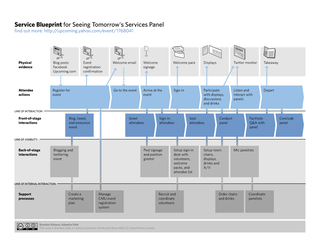Related Research Articles
Customer relationship management (CRM) is a process in which a business or other organization administers its interactions with customers, typically using data analysis to study large amounts of information.

A service is an "(intangible) act or use for which a consumer, firm, or government is willing to pay." Examples include work done by barbers, doctors, lawyers, mechanics, banks, insurance companies, and so on. Public services are those that society as a whole pays for. Using resources, skill, ingenuity, and experience, service providers benefit service consumers. Service is intangible in nature. Services may be defined as acts or performances whereby the service provider provides value to the customer.
In sales, commerce, and economics, a customer is the recipient of a good, service, product or an idea - obtained from a seller, vendor, or supplier via a financial transaction or exchange for money or some other valuable consideration.
The term "marketing mix" is a foundation model for businesses, historically centered around product, price, place, and promotion. The marketing mix has been defined as the "set of marketing tools that the firm uses to pursue its marketing objectives in the target market".

Services marketing is a specialized branch of marketing which emerged as a separate field of study in the early 1980s, following the recognition that the unique characteristics of services required different strategies compared with the marketing of physical goods.
Relationship marketing is a form of marketing developed from direct response marketing campaigns that emphasizes customer retention and satisfaction rather than sales transactions. It differentiates from other forms of marketing in that it recognises the long-term value of customer relationships and extends communication beyond intrusive advertising and sales promotional messages. With the growth of the Internet and mobile platforms, relationship marketing has continued to evolve as technology opens more collaborative and social communication channels such as tools for managing relationships with customers that go beyond demographics and customer service data collection. Relationship marketing extends to include inbound marketing, a combination of search optimization and strategic content, public relations, social media and application development.
The loyalty business model is a business model used in strategic management in which company resources are employed so as to increase the loyalty of customers and other stakeholders in the expectation that corporate objectives will be met or surpassed. A typical example of this type of model is: quality of product or service leads to customer satisfaction, which leads to customer loyalty, which leads to profitability.
The industrialization of services business model is a business model used in strategic management and services marketing that treats service provision as an industrial process, subject to industrial optimization procedures. It originated in the early 1970s, at a time when various quality control techniques were being successfully implemented on production assembly lines.
The Kano model is a theory for product development and customer satisfaction developed in the 1980s by Professor Noriaki Kano, which classifies customer preferences into five categories.
Customer satisfaction is a term frequently used in marketing. It is a measure of how products and services supplied by a company meet or surpass customer expectation. Customer satisfaction is defined as "the number of customers, or percentage of total customers, whose reported experience with a firm, its products, or its services (ratings) exceeds specified satisfaction goals." Customers play an important role and are essential in keeping a product or service relevant; it is, therefore, in the best interest of the business to ensure customer satisfaction and build customer loyalty.
The following outline is provided as an overview of and topical guide to marketing:
Customer retention refers to the ability of a company or product to retain its customers over some specified period. High customer retention means customers of the product or business tend to return to, continue to buy or in some other way not defect to another product or business, or to non-use entirely. Selling organizations generally attempt to reduce customer defections. Customer retention starts with the first contact an organization has with a customer and continues throughout the entire lifetime of a relationship and successful retention efforts take this entire lifecycle into account. A company's ability to attract and retain new customers is related not only to its product or services, but also to the way it services its existing customers, the value the customers actually perceive as a result of utilizing the solutions, and the reputation it creates within and across the marketplace.

Customer experience (CX) is a totality of cognitive, affective, sensory, and behavioral consumer responses during all stages of the consumption process including pre-purchase, consumption, and post-purchase stages. Pine and Gilmore described the experience economy as the next level after commodities, goods, and services with memorable events as the final business product. Four realms of experience include esthetic, escapist, entertainment, and educational components.
The service recovery paradox (SRP) is a situation in which a customer thinks more highly of a company after the company has corrected a problem with their service, compared to how they would regard the company if non-faulty service had been provided. The main reason behind this thinking is that successful recovery of a faulty service increases the assurance and confidence from the customer.
Enterprise engagement is a sub-discipline of marketing and management that focuses on achieving long-term financial results by strategically fostering the proactive involvement and alignment of customers, distribution partners, salespeople, and all human capital outside and inside of an organization. Enterprise engagement is distinct from the traditional sub-disciplines of financial management, marketing, sales, operations, and human resources in that it seeks to achieve long-term success by integrating these various traditional business disciplines to consistently focus the organization on identifying and meeting target audience needs. Enterprise Engagement is related to brand engagement, a term developed in Great Britain in the 2000s to describe an integrated external and internal marketing approach to achieving long-term success for a brand. Enterprise Engagement applies similar principals to the achievement of an organization's overall financial objectives.
Service quality (SQ), in its contemporary conceptualisation, is a comparison of perceived expectations (E) of a service with perceived performance (P), giving rise to the equation SQ=P-E. This conceptualistion of service quality has its origins in the expectancy-disconfirmation paradigm.

The service blueprint is a technique originally used for service design, but has also found applications in diagnosing problems with operational efficiency. The technique was first described by G. Lynn Shostack, a bank executive, in the Harvard Business Review in 1984. The service blueprint is an applied process chart which shows the service delivery process from the customer's perspective. The service blueprint has become one of the most widely used tools to manage service operations, service design and service.
A service guarantee is a marketing tool service firms have increasingly been using to reduce consumer risk perceptions, signal quality, differentiate a service offering, and to institutionalize and professionalize their internal management of customer complaint and service recovery. By delivering service guarantees, companies entitle customers with one or more forms of compensation, namely easy-to-claim replacement, refund or credit, under the circumstances of service delivery failure. Conditions are often put on these compensations; however, some companies provide them unconditionally.

The Journal of Service Research is a quarterly peer-reviewed academic journal that covers the field of business studies. The current editor-in-chief is Ming-Hui Huang. The journal was established by Roland Rust in 1998 and is published by Sage Publications. The Journal of Service Research is sponsored by the Center for Excellence in Service at the University of Maryland’s Robert H. Smith School of Business.
Operations management for services has the functional responsibility for producing the services of an organization and providing them directly to its customers. It specifically deals with decisions required by operations managers for simultaneous production and consumption of an intangible product. These decisions concern the process, people, information and the system that produces and delivers the service. It differs from operations management in general, since the processes of service organizations differ from those of manufacturing organizations.
References
- ↑ James A. Fitzsimmons and Mona J. Fitzsimmmons: Service management: operations, strategy, information technology, 2011, 7th edition, p136.
- ↑ Grönroos, Christian. "Service Quality: The Six Criteria of Good Perceived Service Quality." Review of Business 9, no. Winter (1988): 10-13.
- ↑ Lewis, Barbara R. "Service Promises, Problems and Retrieval. Working Paper." Paper presented at the QUIS, Karlstad, 1996.
- ↑ Stauss, Bernd, and Wolfgang Seidel. Complaint Management. The Heart of CRM. Mason, OH: Thomson, 2005.
- ↑ Andreasen, Alain R., and Arthur Best. "Customers Complain-Does Business Respond?". Harvard Business Review 55, no. July–August (1977): 93-101.
- ↑ Halstead, Diane, Edward A Morash, and John Ozment. "Comparing Objective Service Failures and Subjective Complaints: An Investigation of Domino and Halo Effects." Journal of Business Research 36, no. 2 (1996): 107-15.
- ↑ Gohary, Ali , Hamzelu, Bahman and Alizadeh, Hamid. "Please explain why it happened! How perceived justice and customer involvement affect post co-recovery evaluations: A study of Iranian online shoppers." Journal of Retailing and Consumer Services Volume 31, July 2016, Pages 127-142.
- ↑ Maxham, James G. III. "Service Recovery's Influence on Consumer Satisfaction, Word-of-Mouth, and Purchase Intentions." Journal of Business Research 54, no. October (2001): 11-24.
- ↑ Spreng, Richard A., Gilbert D. Harrell, and Robert D. Mackoy. "Service Recovery: Impact on Satisfaction and Intentions." Journal of Services Marketing 9, no. 1 (1995): 15-23.
- ↑ Smith, Amy K., Ruth N. Bolton, and Janet Wagner. "A Model of Customer Satisfaction with Service Encounters Involving Failure and Recovery." Journal of Marketing Research 36, no. August (1999): 356-72.
- ↑ Tax, Stephen S., Stephen W. Brown, and Murali Chandrashekaran. "Customer Evaluations of Service Complaint Experiences: Implications for Relationship Marketing." Journal of Marketing 62, no. April (1998): 60-76.
- ↑ Hart, Christopher W. L., James L. Heskett, and W. Earl Jr. Sasser. "The Profitable Art of Service Recovery." Harvard Business Review 68, no. July–August (1990): 148-56.
- ↑ McCollough, Michael A., and Sundar G. Bharadwaj. "The Recovery Paradox: An Examination of Customer Satisfaction in Relation to Disconfirmation, Service Quality, and Attribution Based Theories." In Marketing Theory and Applications, edited by Chris T. Allen, 119. Chicago: American Marketing Association, 1992.
- ↑ Schminke, M. et al., 2014. Better than ever ? Employee reactions to ethical failures in organizations , and the ethical recovery paradox. , 123, pp.206–219.
- ↑ Magnini, V.P. et al., 2007. The service recovery paradox: justifiable theory or smoldering myth? Journal of Services Marketing, 21(3), pp.213–225
- ↑ Tax, Stephen S., and Stephen W. Brown. "Recovering and Learning from Service Failures." Sloan Management Review, Fall (1998): 75-88.
- ↑ Johnston, Robert, and Stefan Michel. "Overcoming Recovery Myopia: Three Types of Service Recovery." International Journal of Operation & Production Management 28, no. 1 (2008): 79-99.
- ↑ Michel, Stefan, David E. Bowen, and Robert Johnston. "Why Service Recovery Fails: Tensions among Customer, Employee, and Process Perspectives." Journal of Service Management 20, no. 3 (2009).
- ↑ James A. Fitzsimmons and Mona J. Fitzsimmmons: Service management: operations, strategy, information technology, 2021, 7th edition.